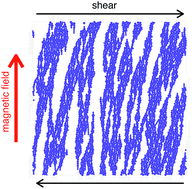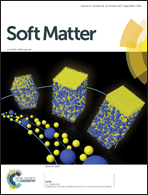On the apparent yield stress in non-Brownian magnetorheological fluids
Abstract
We use simulations to probe the flow properties of dense two-dimensional magnetorheological fluids. Prior results from both experiments and simulations report that the shear stress σ scales with strain rate ![[small gamma, Greek, dot above]](https://www.rsc.org/images/entities/i_char_e0a2.gif) as σ ∼
as σ ∼ ![[small gamma, Greek, dot above]](https://www.rsc.org/images/entities/i_char_e0a2.gif) 1−Δ, with values of the exponent ranging between 2/3 < Δ ≤ 1. However it remains unclear what properties of the system select the value of Δ, and in particular under what conditions the system displays a yield stress (Δ = 1). To address these questions, we perform simulations of a minimalistic model system in which particles interact via long ranged magnetic dipole forces, finite ranged elastic repulsion, and viscous damping. We find a surprising dependence of the apparent exponent Δ on the form of the viscous force law. For experimentally relevant values of the volume fraction ϕ and the dimensionless Mason number Mn (which quantifies the competition between viscous and magnetic stresses), models using a Stokes-like drag force show Δ ≈ 0.75 and no apparent yield stress. When dissipation occurs at the contact, however, a clear yield stress plateau is evident in the steady state flow curves. In either case, increasing ϕ towards the jamming transition suffices to induce a yield stress. We relate these qualitatively distinct flow curves to clustering mechanisms at the particle scale. For Stokes-like drag, the system builds up anisotropic, chain-like clusters as Mn tends to zero (vanishing strain rate and/or high field strength). For contact damping, by contrast, there is a second clustering mechanism due to inelastic collisions.
1−Δ, with values of the exponent ranging between 2/3 < Δ ≤ 1. However it remains unclear what properties of the system select the value of Δ, and in particular under what conditions the system displays a yield stress (Δ = 1). To address these questions, we perform simulations of a minimalistic model system in which particles interact via long ranged magnetic dipole forces, finite ranged elastic repulsion, and viscous damping. We find a surprising dependence of the apparent exponent Δ on the form of the viscous force law. For experimentally relevant values of the volume fraction ϕ and the dimensionless Mason number Mn (which quantifies the competition between viscous and magnetic stresses), models using a Stokes-like drag force show Δ ≈ 0.75 and no apparent yield stress. When dissipation occurs at the contact, however, a clear yield stress plateau is evident in the steady state flow curves. In either case, increasing ϕ towards the jamming transition suffices to induce a yield stress. We relate these qualitatively distinct flow curves to clustering mechanisms at the particle scale. For Stokes-like drag, the system builds up anisotropic, chain-like clusters as Mn tends to zero (vanishing strain rate and/or high field strength). For contact damping, by contrast, there is a second clustering mechanism due to inelastic collisions.



 Please wait while we load your content...
Please wait while we load your content...